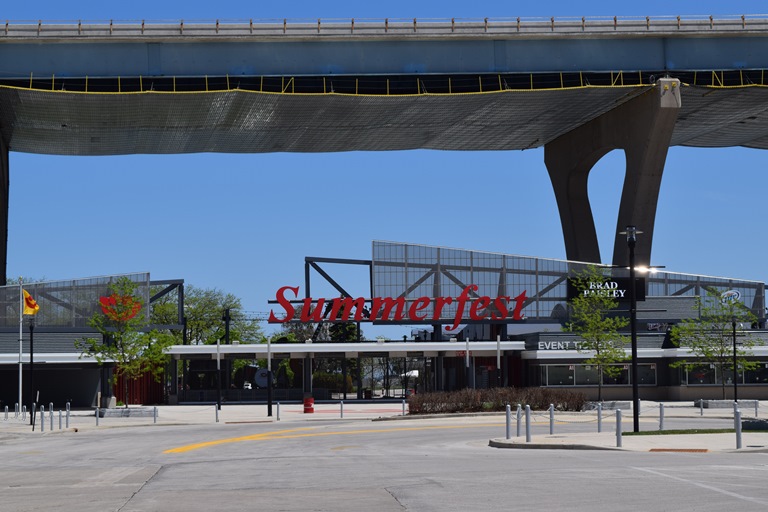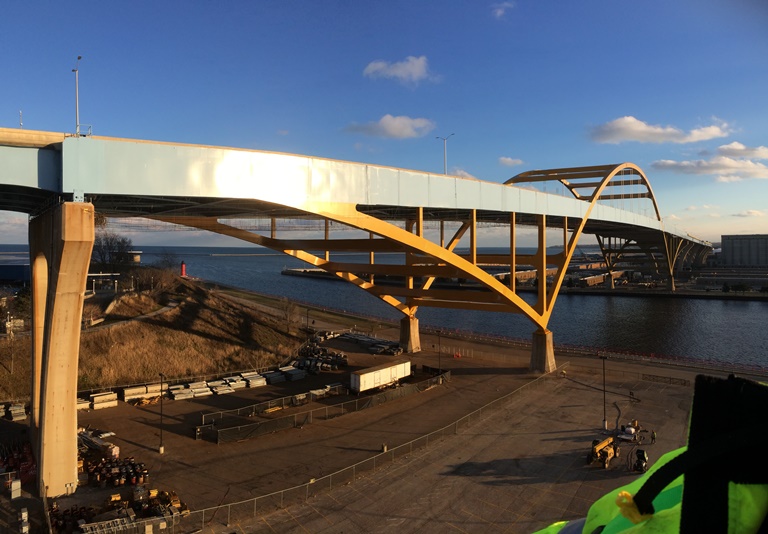For some, driving over bridges is filled with anxiety. For a few drivers crossing the Daniel Hoan Memorial Bridge in December 2000, that anxiety probably went up a few notches. With motorists above, a girder of the then 28-year-old bridge in Milwaukee, Wis., started to crack and sag. Although no injuries occurred, the steel arch bridge was closed immediately and repairs started soon after.
With such a history, it’s no wonder that in December 2013, the state wanted to bring this iconic bridge back to a situation befitting its namesake, lawyer and longest-serving past Milwaukee mayor Daniel Hoan. For Thomas Industrial Coatings, that work would include coating approximately 1,740,000 square feet (161,651.3 m²) of steel!
Customs and Concerns
Sr. Project Manager Josh Teddleton led the Thomas Industrial Coatings (TIC) crew on this two-year-long project, which was broken up into two sections: the superstructure, which covered the main arch and cables above the road deck, and the substructure, which included the horizontal structural steel covering the approaches from north to south and the lower arches.
Before any work could start, 30 members of the crew were off to the process improvement races. They began by installing a Safespan platform to help keep passersby and workers safe. According to Teddleton, that was “definitely challenging.” They also used containment systems engineered and approved by the client to help in that area.
With the site set to go, the crew then started to tackle the prep and coat portion of the job. “Once we got up to blasting or painting, the crew grew exponentially,” Teddleton explained. This portion required up to 60 crew members from TIC. To prep, they blasted the structural steel to NACE No. 2/Society for Protective Coatings (SSPC) Surface Preparation (SP) 10: Near-White Blast Coating. They used recyclable medium hardness steel grit supplied by IDS Blast, two ARS six-pot S Class Super Units, and two Atlantic Design Inc. (ADI) V60s.
“As far as technique wise, there’s nothing too extravagant as to what we did,” Teddleton explained. “Mainly what we had to be cognizant was using steel grit.” That was because of the water runoff from the concrete pours, which could “trash” the abrasive. That meant being aware of other trades on the job and coordinating schedules. “We had to do a little maneuvering at times to allow the other contractors in the areas that we wanted to go in work in — just be flexible, communicate, adjust the plan,” he continued. “It doesn’t have to be set in stone.”
Sound Control
Although the crew was working up to 130 feet (39.6 m) off the ground and above traffic, there was still a concern for the surrounding areas.
The initial contract called for a north-bound first, south-bound second work strategy. But Teddleton soon noticed that would require a hard stop in the installation process during the summer months. Because a park sits at the northern edge of the bridge where many events take place in the warmer weather, he knew the initial schedule would put the crew at the section of the bridge closest to the park during the event season. “It seemed like every weekend in the summer was an event,” Teddleton said. That was something that would not be possible, so that would inevitably mean a delay — not ideal.

Teddleton suggested a different strategy and also set up containment by Eagle Industries and completed regular sound decibel readings. Then, on a case-by-case basis, Teddleton would walk with the client rep around the jobsite during work hours to get approval for continuing work during an event.
The containment also helped keep any lead from entering the surrounding environment. Unless it’s heavy metal music, concertgoers don’t want lead at their concert! But it wasn’t possible to keep the other tradespeople out of the area.
“We couldn’t necessarily quarantine off a part of the structure,” Teddleton explained. “We did have regulated areas, but we had to allow access.” There were welders, for instance, on site who needed to move around, so TIC was sure to use signage and constant communication. “That’s challenging at a multiple site with lead abatement work,” he said. “The biggest part was communication really…We’d communicate with the other trades, let them know what areas were accessible that day, and what areas were not.”
Safety System
The crew paid attention to safety throughout the entire project. They wore special climbing helmets by Petzl with visors and chin straps to help with fogging, especially during the colder months. And for blasting, they wore RPB Safety Nova 2000 air-supplied respirators, Pirate Brand blast suits, and rubber blasting gloves, also by RPB Safety.
Once they were done blasting, the same crew would then prime and stripe coat the area, which meant donning new protective gear. Wearing 3M series 6000 full-face respirators with organic vapor cartridges, Tyvek suits, nitrile-lined gloves, and washable hoods, they applied Sherwin-Williams’ Zinc Clad III HS primer and a stripe coat at 3–5 mils (76.2–127.0 microns) each, a coat of Macropoxy 646 Fast Cure Epoxy at 5–10 mils (127.0–254.0 microns), and Acrolon 218 HS finish coat at 3–6 mils (76.2–152.4 microns) dry film thicknesses (DFT). The full coats were spray applied while the stripe coats were applied with brushes. The topcoat was yellow for the arch and blue for the structural steel. Also, three third-party inspectors from Greenman Pederson Inc. worked throughout the project to ensure quality control of the blasting and painting.
The units forged ahead: blast, paint, quality control, and inspection. “There was a containment crew that was constantly keeping one containment out in front of it,” Teddleton explained. He called it a perpetual system. He continued, “That way you’d never stop blasting other than to spray the primer on.” They also relied on TruQC software to keep the data organized.
For the bridge cables, the crew used a coating by Bridon called Metal Coat. “Bridon comes out of the U.K., so it’s not a product that’s used a whole lot over in the United States. But it was spec’d for the cable coating,” Teddleton said. According to him, the material has to go through customs before coming into the United States, which took four to five weeks, so another layer of coordination here was crucial.
Key to Success
Organization and coordination were huge undertakings that required a quick maneuver from headquarters for processing manpower. “Kudos to our owner who runs that program here,” Teddleton said. “Without that I could be four or five guys short. At any given time I had 25 guys with a blast nozzle in their hand.” Twenty-five guys blasting at this project, 30 various jobs around the site, another job going on down the road, “not to mention all the other Thomas Industrial crews working across the country,” Teddleton explained. “That talent pool can get shallow pretty quick.”
Finding “people who are qualified to help us do this work” and having support from the home office were key for the success of Teddleton and his crew on this coordinated project.
